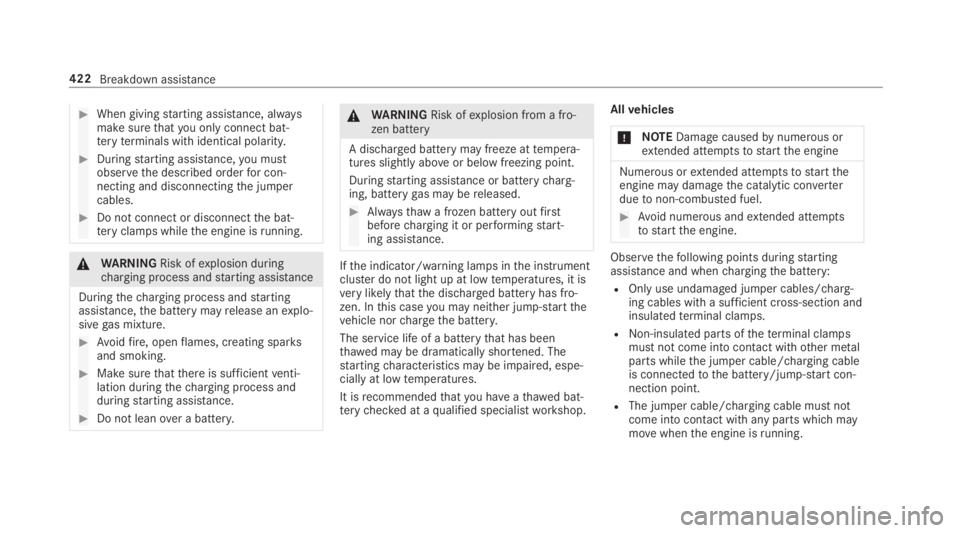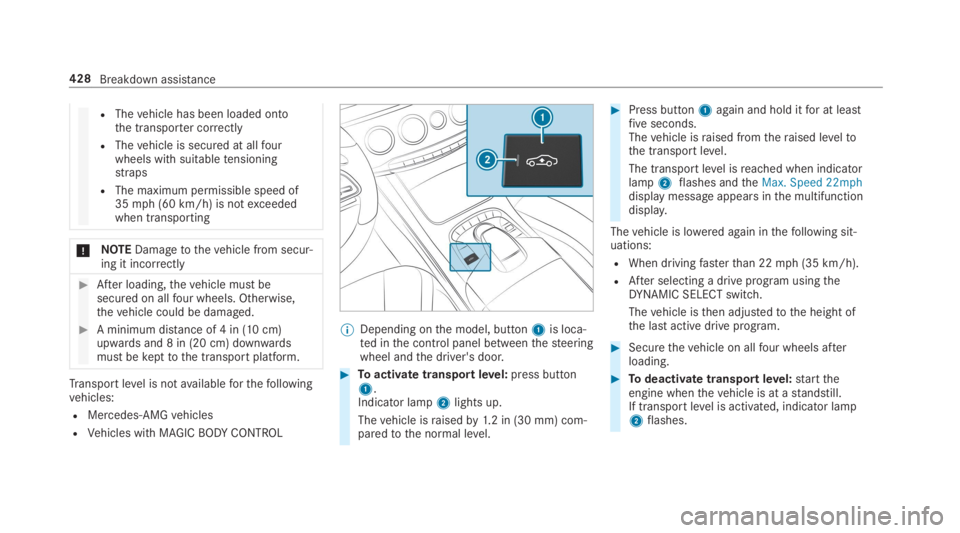2019 MERCEDES-BENZ S CLASS engine
[x] Cancel search: enginePage 423 of 578

Wear safetyglasses.
Keepchildrenaway.
Observethis Operator's Manual.
Observethefollowing ifyou do not intendtousethevehicleover anextended period of time:
RActivatestandby mode.
RAlternatively: connectthe batterytoa bat‐terycharger approvedbyMercedes-Benz orconsult aqualified specialistworkshoptodisconnectthe battery.
Notes onstarting assistance and oncharg‐ingthe12V battery
Vehicles with a lithium-ion batteryWhenchargingthe battery and duringstartingassistance, alwaysusethe jump-startconnec‐tion point inthe engine compartment.
*NOTEDamagetothe battery fromover‐voltage
Whencharging using a batterycharger with‐out a maximumchargingvoltage,the batteryorthe on-board electronics may be damaged.
#Only use batterychargerswith a maxi‐mumchargingvoltage of14.4V.
AllothervehiclesWhenchargingthe battery and duringstartingassistance, alwaysusethe jump-startconnec‐tion point inthe engine compartment.
*NOTEDamagingthe batterythroughovervoltage
Whencharging using a batterycharger with‐out a maximumchargingvoltage,the batteryorthevehicle electronics may be damaged.
#Only use batterychargerswith a maxi‐mumchargingvoltage of14.8V.
&WARNINGRisk ofexplosion fromhydro‐gengas igniting
A batterygenerateshydrogengas duringthecharging process. Ifthere is a short circuit orsparksstarttoform,there is a danger ofthehydrogengas igniting.
#Make surethatthe positiveterminal ofthe connected battery does not comeinto contact withvehicle parts.
#Never place metal objects ortools on abattery.
#When connecting and disconnectingthebattery,you must observethe descri‐bed orderforthe battery clamps.
Breakdown assistance421
Page 424 of 578

#When givingstarting assistance, alwaysmake surethatyou onlyconnect bat‐teryterminals with identical polarity.
#Duringstarting assistance,you mustobservethe described orderfor con‐necting and disconnectingthe jumpercables.
#Do not connect or disconnectthe bat‐teryclamps whilethe engine isrunning.
&WARNINGRisk ofexplosion duringcharging process andstarting assistance
Duringthecharging process andstartingassistance,the battery mayrelease anexplo‐sivegas mixture.
#Avoidfire, openflames, creating sparksand smoking.
#Make surethatthere is sufficientventi‐lation duringthecharging process andduringstarting assistance.
#Do not leanover a battery.
&WARNINGRisk ofexplosion from a fro‐zen battery
A discharged battery may freeze attempera‐tures slightly aboveor below freezing point.
Duringstarting assistance or batterycharg‐ing, batterygas may bereleased.
#Alwaysthawa frozen batteryoutfirstbeforecharging it or performingstart‐ing assistance.
Ifthe indicator/warning lamps inthe instrumentcluster do not light up at lowtemperatures, it isverylikelythatthe discharged battery has fro‐zen. Inthis caseyou may neither jump-startthevehicle norchargethe battery.
The service life of a batterythat has beenthawed may be dramatically shortened. Thestartingcharacteristics may be impaired, espe‐cially at lowtemperatures.
It isrecommendedthatyou haveathawed bat‐terychecked at aqualified specialistworkshop.
Allvehicles
*NOTEDamagecausedbynumerous orextended attemptstostartthe engine
Numerous orextended attemptstostarttheengine may damagethe catalytic converterduetonon-combusted fuel.
#Avoid numerous andextended attemptstostartthe engine.
Observethefollowing points duringstartingassistance and whenchargingthe battery:
ROnly use undamaged jumper cables/charg‐ing cables with a sufficient cross-section andinsulatedterminal clamps.
RNon-insulated parts oftheterminal clampsmust not come into contact withother metalparts whilethe jumper cable/charging cableis connectedtothe battery/jump-startcon‐nection point.
RThe jumper cable/charging cable must notcome into contact withany parts which maymovewhenthe engine isrunning.
422Breakdown assistance
Page 425 of 578

RAlways make surethat neitheryou northebattery is electrostaticallycharged.
RKeepawayfromfireand openflames.
RDo not leanoverthe battery.
Observethe additionalfollowing points whenchargingthe battery:
ROnly use batterychargerstested andapprovedfor Mercedes-Benz.
RReadthe batterycharger's operating instruc‐tions beforechargingthe battery.
Observethe additionalfollowing points duringstarting assistance:
RStarting assistance may only be providedusing batteries with a nominalvoltage of12V.
RThevehicles must nottouch.
RGasoline engine:Onlyacceptstarting assis‐tance ifthe engine andexhaust system arecold.
Starting assistance andchargingthe12 Vbattery
Requirements:RThevehicle is secured withthe electric park‐ing brake.
RThe transmission is in position�].
RThe ignition and all electrical consumers areswitched off.
RThe hood is open.
#Slide cover3of positive clamp4onthejump-starting connection point inthe direc‐tion ofthe arrow.
#Connect positive clamp4onyourvehicletothe positive pole ofthe donor battery usingthe jumper cable/charging cable. Alwaysbegin with positive clamp4onyourownvehiclefirst.
Breakdown assistance423
Page 426 of 578

#Duringstarting assistance:starttheengine ofthe donorvehicle andrun at idlespeed.
#Connectthe negative pole ofthe donor bat‐teryandground point5ofyourownvehiclebyusingthe jumper cable/charging cable.Begin withthe donor batteryfirst.
#Duringstarting assistance:starttheengine ofyourownvehicle.
#Duringthecharging process:startthecharging process.
#Duringstarting assistance:letthe enginesrunfor several minutes.
#Duringstarting assistance:before discon‐nectingthe jumper cable, switch on an elec‐trical consumer inyourownvehicle, e.g.therear windowdefroster or lighting.
Whenthestarting assistance/charging processis complete:
#First,removethe jumper cable/chargingcable from ground point5and negativepole ofthe donor battery,then from positiveclamp4and positive pole ofthe donor bat‐
tery. Begin eachtime with the contacts onyourownvehiclefirst.
#Afterremovingthe jumper cable/chargingcable, close cover3of positive clamp4.
Further information can be obtained at aquali‐fied specialistworkshop.
Replacing the12V battery
#Observethe notes onthe12V battery(→page419).
Mercedes-Benzrecommendsthatyou havethe12V batteryreplaced at aqualified specialistworkshop, e.g. at an authorized Mercedes-BenzCenter.
Observethefollowing notes ifyouwanttoreplacethe batteryyourself:
RAlwaysreplace afaulty batterywith a batterywhich meetsthe specificvehiclerequire‐ments.
Thevehicle is equipped with anAGMtechnol‐ogy battery (Absorbent Glass Mat) or a lith‐ium-ion battery.Fullvehicle functionality is
only guaranteed with anAGM battery or lith‐ium-ion battery.For safetyreasons,Mercedes-Benzrecommendsthatyou onlyuse batteries which havebeentested andapprovedforyourvehiclebyMercedes-Benz.
RCarryover detachable parts, such asventhoses, elbowfitting orterminal coversfromthe battery beingreplaced.
RMake surethatthevent hose is alwayscon‐nectedtothe original opening onthe side ofthe battery.
Install anyexisting or supplied cell caps.
Otherwise,gases or battery acid couldescape.
RMake surethat detachable parts arerecon‐nected inthe sameway.
Towstarting ortowingaway
Permittedtowing methods
Plug-inhybrid:observethe notes inthe Supple‐ment. Otherwise,you may notrecognize dan‐gers.
424Breakdown assistance
Page 428 of 578

Towingthevehicle with bothaxles ontheground
#Observethe notes onthe permittedtowingmethods (→page 424).
#Make surethatthe battery is connected andcharged.
Whenthe battery is discharged,thefollowingactions cannot be performed:
Rthe engine cannotbestarted
Rthe electric parking brake cannotbereleasedor applied
Rthe automatic transmission cannotbe shiftedtoposition�\\or�]
%Ifthe automatic transmission cannotbe shif‐tedtoposition�\\, orthe multifunction dis‐play inthe instrument cluster does not showanything, havethevehicle transportedaway(→page 427). Atowingvehicle with liftingequipment isrequiredforvehicle transporta‐tion.
*NOTEDamagedueto towingawayatexcessively high speeds orover long dis‐tances
The drivetrain could be damaged whentow‐ing atexcessively high speeds orover longdistances.
#Atowing speed of 30mph (50 km/h)must not beexceeded.
#Atowing distance of 30 miles (50 km)mustnot beexceeded.
&WARNINGRisk of accident whentowingavehicle which istoo heavy
Ifthevehicle beingtow-started ortowedawayis heavierthanthe permissible grossmass ofyourvehicle,thefollowing situationscan occur:
RThetowingeye may become detached.
RThevehicle/trailer combination mayswerveorevenoverturn.
#If anothervehicle istow-started ortowedaway, itsweight must notexceed
the permissible gross mass ofyourownvehicle.
If avehicle must betow-started ortowedaway,itsweight must notexceedthe permissible grossmass ofthetowingvehicle.
#Information onthe permissible gross mass ofthevehicle can befound onthevehicle iden‐tification plate (→page 466).
#Do not openthe driver's door or frontpassenger door,otherwisethe automatictransmission automatically shiftstoposition�].#Installthetowingeye (→page 429).
#Fastenthetow bar.
*NOTEDamageduetoincorrect connec‐tion
#Only connectthetowrope ortow bartothetowingeyes.
#Deactivatethe automatic locking mechanism(→page 68).
426Breakdown assistance
Page 430 of 578

RThevehicle has been loaded ontothe transporter correctly
RThevehicle is secured at allfourwheels with suitabletensioningstraps
RThe maximum permissible speed of35mph (60 km/h) is notexceededwhen transporting
*NOTEDamagetothevehicle from secur‐ing it incorrectly
#After loading,thevehicle must besecured on allfour wheels. Otherwise,thevehicle could be damaged.
#A minimum distance of 4 in (10 cm)upwards and 8 in (20 cm) downwardsmust bekepttothe transport platform.
Transport level is notavailableforthefollowingvehicles:
RMercedes-AMGvehicles
RVehicles with MAGICBODYCONTROL
%Depending onthe model, button1is loca‐ted inthe control panel betweenthesteeringwheel andthe driver's door.
#Toactivate transportlevel:press button1.Indicator lamp2lights up.
Thevehicle israisedby1.2 in (30 mm) com‐paredtothe normal level.
#Press button1again and hold itfor at leastfiveseconds.Thevehicle israised fromtheraised leveltothe transport level.
The transport level isreached when indicatorlamp2flashes andtheMax. Speed 22mphdisplay message appears inthe multifunctiondisplay.
Thevehicle is lowered again inthefollowing sit‐uations:
RWhen drivingfasterthan 22mph (35 km/h).
RAfter selecting a drive program usingtheDYNAMIC SELECT switch.
Thevehicle isthen adjustedtothe height ofthe last active drive program.
#Securethevehicle on allfour wheels afterloading.
#Todeactivate transportlevel:starttheengine whenthevehicle is at astandstill.If transportlevel is activated, indicator lamp2flashes.
428Breakdown assistance
Page 432 of 578

*NOTEDamageduetoincorrect use ofthetowingeye
When atowingeye is usedtorecover avehi‐cle,thevehicle may be damaged inthe proc‐ess.
#Only usethetowingeyeto towawayortowstartthevehicle.
Tow-startingthevehicle (emergency enginestart)
*NOTEDamagetothe automatic trans‐mission dueto towstarting
The automatic transmission may be damagedinthe process oftowstartingvehicles withautomatic transmission.
#Vehicles with automatic transmissionmust not betowstarted.
#Vehicles with automatic transmission mustnot betow-started.
Electrical fuses
Notes on electrical fuses
&WARNINGRisk of accident and injurydueto overloaded lines
Ifyou manipulate or bridge afaulty fuse or ifyoureplace it with a fuse with a higheramperage,the electric line could beoverloa‐ded.
This couldresult in afire.
#Alwaysreplacefaulty fuses with speci‐fied new fuses containingthe correctamperage.
*NOTEDamagecausedbyincorrect fuses
Incorrect fuses may cause damagetoelectri‐cal components or systems.
#Only use Mercedes-Benz approvedfuses withthe correct fuserating.
Blown fuses mustbereplaced with fuses ofthesamerating, whichyou canrecognizebythecolor and fuserating. The fuseratings and fur‐
ther informationtobe observed are listed inthefuse assignment diagram.
*NOTEDamageor malfunctions causedbymoisture
Moisture may cause damagetothe electricalsystem or cause ittomalfunction.
#Whenthe fuse box is open, make surethat no moisture can enterthe fusebox.
#When closingthe fuse box, make surethatthe seal ofthe lid is positioned cor‐rectly onthe fuse box.
Ifthe newly inserted fuse also blows, havethecause traced andrectified at aqualified special‐istworkshop, e.g. an authorized Mercedes-BenzCenter.
Ensurethefollowing beforereplacing a fuse:
RThevehicle is secured againstrollingaway
RAll electrical consumers are switched off
RThe ignition is switched off
430Breakdown assistance
Page 433 of 578

The electrical fuses are located inthefollowingfuse boxes:
RFuse box inthe engine compartment onthedriver's side (→page 431)
RFuse box onthe driver's side ofthe cockpit(→page 432)
RFuse box inthe front passengerfootwell(→page 432)
RFuse box inthe trunk ontheright-hand sideofthevehicle when viewed inthe direction oftravel (→page 433)
Opening and closingthe fuse box intheengine compartment
Requirements:RObservethe notes on electrical fuses(→page 430).
RHavethefollowingtoolsreadilyavailable:
-a dry cloth
-a screwdriver
Opening
&WARNINGRisk of injuryfrom usingthewindshield wipers whilethe engine hoodis open
Whenthe engine hood is open andthe wind‐shield wipers are set in motion,you can betrappedbythe wiper linkage.
#Always switch offthe windshield wipersand ignition before openingthe enginehood.
#Releaseretaining clips1.Pull cover2up.
Breakdown assistance431